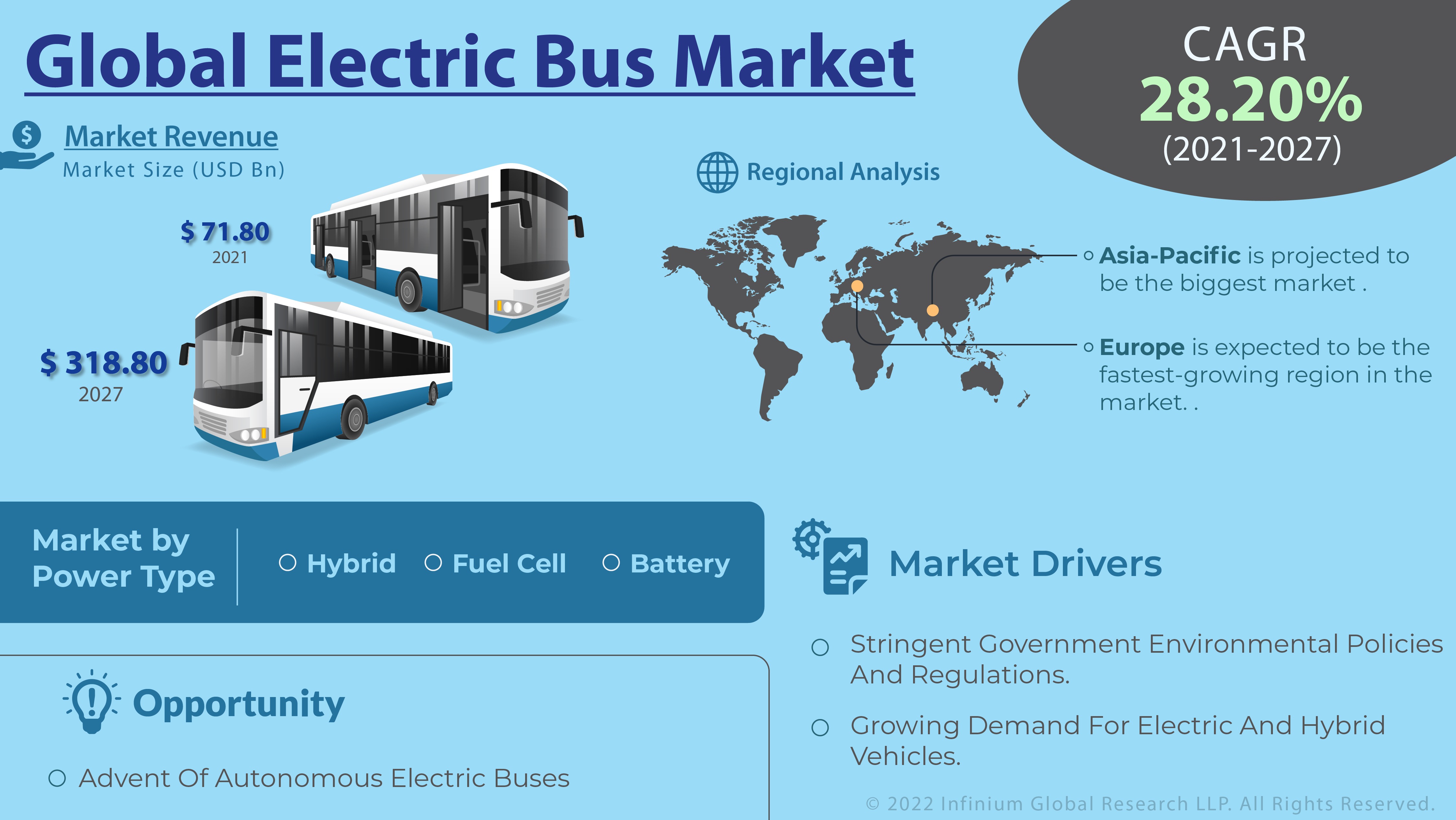Electric Bus Market (Power Type - Hybrid, Fuel Cell, and Battery; Bus Type - Light Bus, Medium Bus, and High Seating Capacity Bus; End User - Government, and Fleet Operators): Global Industry Analysis, Trends, Size, Share and Forecasts to 2027
A recent report published by Infinium
Global Research on the electric bus market provides in-depth analysis of segments
and sub-segments in the global as well as regional electric bus market. The
study also highlights the impact of drivers, restraints, and macro indicators
on the global and regional electric bus market over the short term as well as
long term. The report is a comprehensive presentation of trends, forecast and
dollar values of the global electric bus market. According to the report, the
global electric bus market is projected to grow at a CAGR of 28.20% over the
forecast period of 2021-2027.
Market Insight
The reported study estimated the
market for Electric Bus to be about USD 71.80 billion in 2021, and will reach
more than 318.80 billion in 2027, with a Compound Annual Growth Rate of 28.20%,
over the forecast period (2021-2027). An electric bus is a zero-emission bus
that does not run on fossil fuels such as petrol and diesel and uses electrical
energy for propulsion stored in batteries or in fuel cells. The electric bus
does not have a conventional engine running on combustion thus, it makes
minimal sound and is helpful in reducing sound pollution caused due to
vehicles. Electric buses come in different configurations with different loads
and seating capacities. Normally the electric buses can be charged in a span of
1-3 hours. They are used for intracity and intercity transportation. The
adoption of electric buses is helping governments around the world to
accomplish their environmental objectives cut down on fuel costs and provide
optimum service to the general public.
The governments are adopting
stringent environmental policies and regulations to fight climate change and
global warming as well as accomplish their environmental and sustainability
goals. In 2019, European Union adopted new law describing the green public
procurement rules for buses. and set goals for the adoption of low-emission
public buses by 2030. Similarly, a significant amount of investments is being
poured into infrastructures such as charging stations and repair and
maintenance depots for electric busses. This has boosted the confidence of
electric bus makers and confidently field their buses for various public
procurement tenders. Rising fuel costs and environmental awareness regarding
the pollution caused by conventional vehicles have led to an increase in the
demand for hybrid and electric vehicles. Conventional vehicles are one of the
largest emitters of greenhouses gases which are causing global warming. With
rising fuel costs, the commercial fleet operators are adding electric busses to
their fleets as they have low fuel costs as compared to conventional vehicles.
The growing supporting infrastructure is also aiding the demand for electric
busses. The only factor restraining the growth of the market is the high cost
of maintenance and required manpower of electric busses. Though, new
opportunities are expected to arise as autonomous vehicle busses are being
fielded by the market players.
Asia-Pacific is projected to be
the biggest market in the global electric bus market. Europe is expected to be
the fastest-growing region in the market.
Developing countries such as India and China along with developed
countries such as Japan and South Korea are adding electric busses into their
public transportation fleets. China and India are focusing on zero-emission
vehicles adopting favorable laws and investing in required infrastructure
simultaneously. The electric bus makers such as BYD Company Limited, Zhongtong
Bus Holding Co., Ltd, Shenzhen Wuzhoulong Motors Co., Ltd, and TATA Motors have
their presence in the region making Asia-Pacific one of the global
manufacturing hubs for electric buses.

Segment Covered
The report on global electric bus
market covers segments such as power type, bus type, and end user. On the basis
of power type, the sub-markets include hybrid, fuel cell, and battery. On the
basis of bus type, the sub-markets include light bus, medium bus, and high
seating capacity bus. On the basis of end user, the sub-markets include
government, and fleet operators.
Companies Profiled:
The report provides profiles of
the companies in the market such as BYD Company Limited, Proterra Inc., Solaris
Bus & Coach SA, Zhongtong Bus Holding Co., Ltd, Shenzhen Wuzhoulong Motors
Co., Ltd, AB Volvo, Daimler AG, EBUSCO BV, New Flyer Industries Inc., and TATA
Motors.
Report Highlights:
The report provides deep insights
into the demand forecasts, market trends, and micro and macro indicators. In
addition, this report provides insights into the factors that are driving and
restraining the growth in this market. Moreover, The IGR-Growth Matrix analysis
given in the report brings an insight into the investment areas that existing
or new market players can consider. The report provides insights into the
market using analytical tools such as Porter's five forces analysis and DRO
analysis of electric bus market. Moreover, the study highlights current market
trends and provides forecast from 2021-2027. We also have highlighted future
trends in the market that will affect the demand during the forecast period.
Moreover, the competitive analysis given in each regional market brings an
insight into the market share of the leading players.
